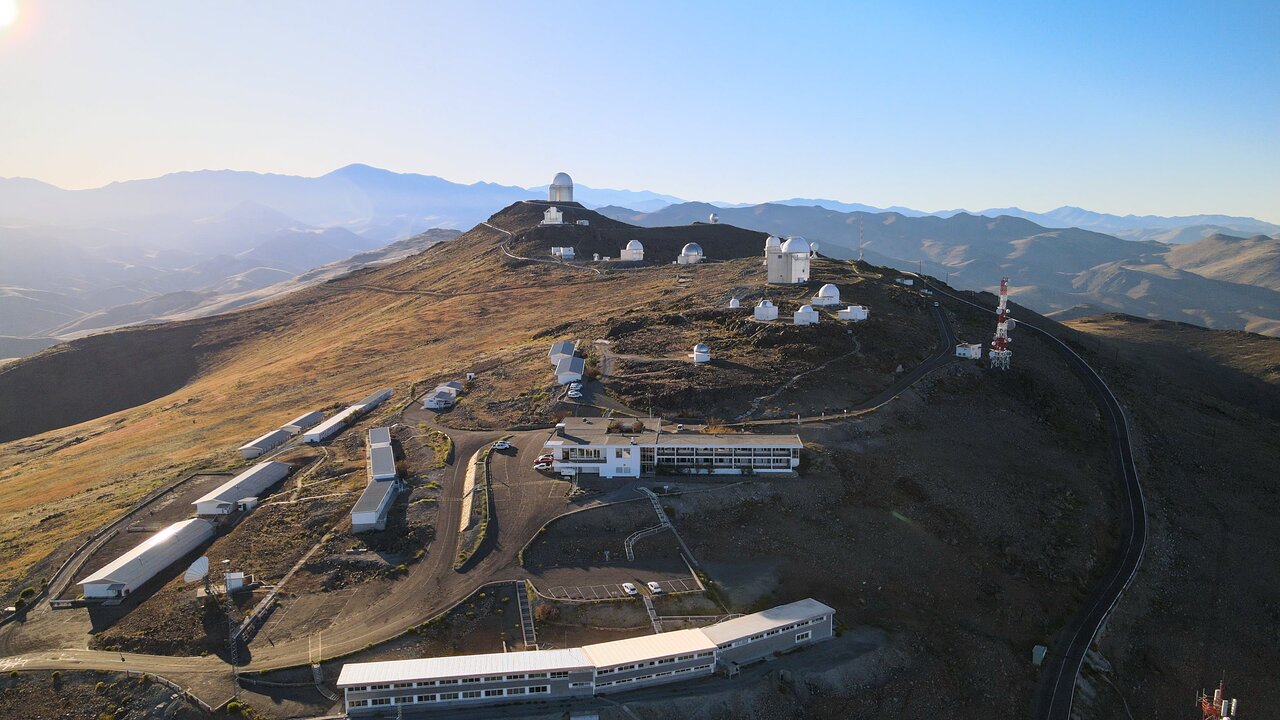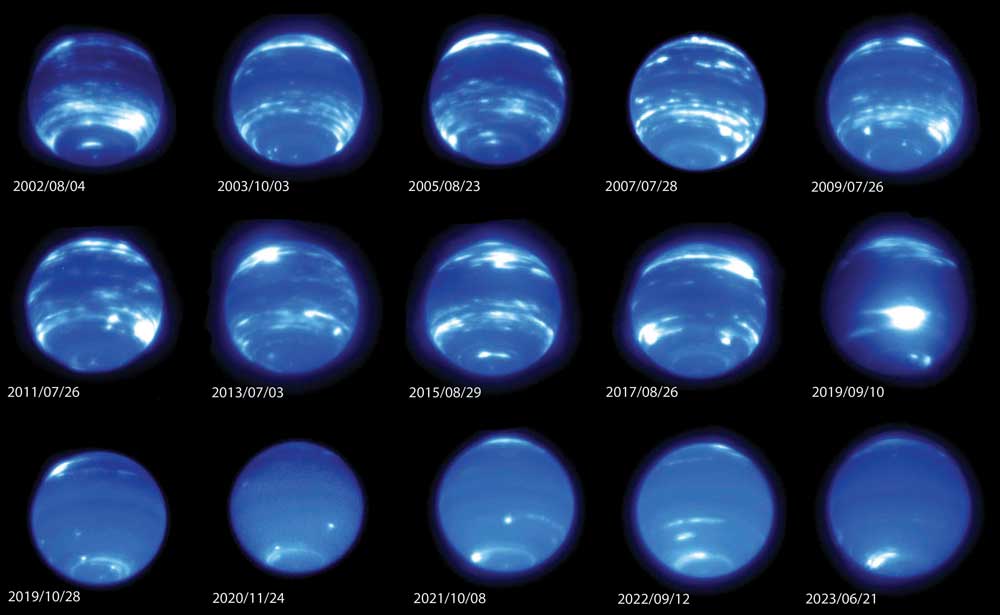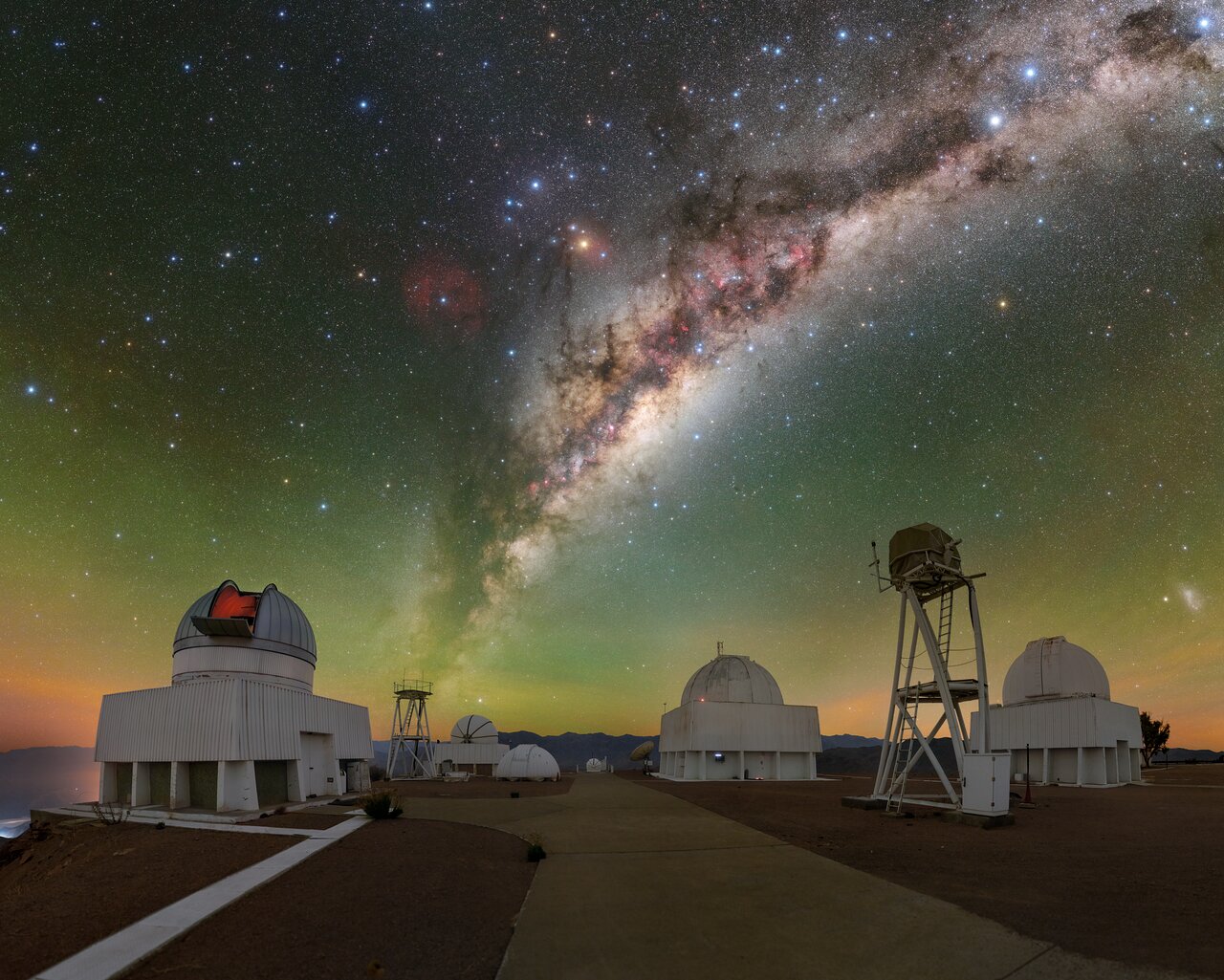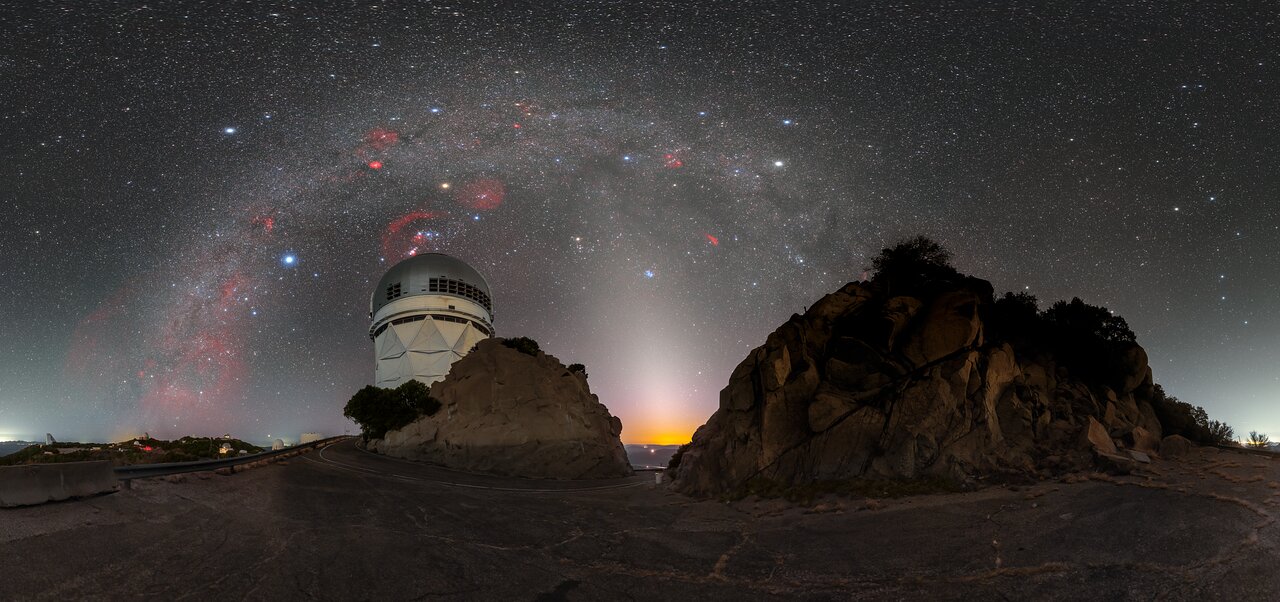Page 2 of 2
Re: Found Images: 2023 August
Posted: Sat Aug 19, 2023 10:09 pm
by starsurfer
Copeland's Septet (Hickson 57)
https://www.chart32.de/index.php/component/k2/item/409
Copyright: CHART32
Processing: Bernd Flach-Wilken
Re: Found Images: 2023 August
Posted: Sat Aug 19, 2023 10:14 pm
by starsurfer
NGC 7342 region
http://www.capella-observatory.com/Imag ... 42EtAl.htm
Copyright: Josef Pöpsel, Rainer Raupach, Frank Sackenheim and Stefan Binnewies
NOIRLab: A Pantheon above WIYN (KPNO)
Posted: Mon Aug 21, 2023 1:42 pm
by bystander
A Pantheon above WIYN
NOIRLab Image of the Month | KPNO | 2023 Aug 16
The Milky Way and colorful celestial objects stretch over Kitt Peak National Observatory (
KPNO), a Program of NSF’s NOIRLab, in this image of the
WIYN 3.5-meter Telescope. This telescope is used to
hunt for and characterize exoplanets with the
NEID (pronounced NOO-id, rhymes with “fluid”) spectrograph, a state-of-the-art instrument for highly precise measurements of stellar movements.
Above the WIYN telescope is a pantheon of constellations and their stellar companions. To the left, near the tree, is the brightest star in the sky,
Sirius, that indicates the constellation
Canis Major (the Great Dog). To its right is the constellation
Orion (the Hunter) marked by the bright red
supergiant star
Betelgeuse of Orion’s ‘right shoulder’ and three inline stars that form his ‘
belt’. The glowing red regions in the constellation are part of the
Orion molecular cloud complex. Shockwaves from newly formed stars excite these and other areas of
molecular hydrogen, which then appear prominently, like in this image, using proper photographic techniques. Further to the right, above the WIYN telescope, is the constellation
Taurus (the Bull) and the
open star cluster Messier 45, also known as the
Pleiades (the Seven Sisters). Above the Milky Way is the constellation
Gemini (the Twins), evident from the two brightest stars at the top of the image that are the twins’ ‘heads’. ...
ESO: Home is where the telescopes are (La Silla)
Posted: Mon Aug 21, 2023 1:52 pm
by bystander
Home is where the telescopes are
ESO Picture of the Week | 2023 Aug 21
Welcome to ESO’s
La Silla Observatory, home to several telescopes since the 1960s and the
setting of this Picture of the Week. Located 600 km north of Chile’s capital Santiago, La Silla sits at around 2400 meters above sea level.
More than just the telescopes live at this idyllic location: the staff who run them do too. Astronomers, engineers and support staff spend shifts of several days working on-site, and the buildings in the foreground allow them to live, work and relax in the harsh conditions of the Atacama desert. The building at the centre contains bedrooms, a canteen, a gym and a cinema room, among other facilities. On the left we can see dormitories where visiting astronomers can rest after a long night observing the cosmos. Meanwhile, the long white building right at the bottom is the New Operations Building, from which the New Technology Telescope (
NTT),
ESO 3.6-metre and
MPG/ESO 2.2-metre telescopes are controlled.
These telescopes, amongst others found on this remote mountain, are heavy hitters in the astronomical world. Perched at the highest point is the ESO 3.6-metre telescope, famed for hosting one of the world’s foremost extrasolar planet hunters: the High Accuracy Radial velocity Planet Searcher (
HARPS) instrument. Another groundbreaker is the NTT, which was a first leap in the field of active optics: telescope mirrors are so heavy that they bend under their own weight, but with
active optics we can adjust their shape during observations, delivering optimal image quality.
ESA: A Sparkling Galactic Neighbour (ESO 300-16)
Posted: Mon Aug 21, 2023 2:05 pm
by bystander
A Sparkling Galactic Neighbour
ESA Hubble Image of the Week | 2023 Aug 21
The galaxy
ESO 300-16 looms over this image from the NASA/ESA Hubble Space Telescope. This galaxy, which lies 28.7 million light-years from Earth in the constellation
Eridanus, is a ghostly assemblage of stars which resembles a sparkling cloud. A rogue’s gallery of distant galaxies and foreground stars complete this astronomical portrait, which was captured by the
Advanced Camera for Surveys.
This observation is one of a series which aims to get to know our galactic neighbours; around three quarters of the known galaxies suspected to lie within 10 megaparsecs of Earth have been observed by Hubble in enough detail to resolve their brightest stars and establish the distances to these galaxies. A team of astronomers proposed using small gaps in Hubble’s observing schedule to acquaint ourselves with the remaining quarter of the nearby galaxies.
The megaparsec — meaning one million parsecs — is a unit used by astronomers to chart the mind-bogglingly large distances involved in astronomy. The motion of Earth around the Sun means that stars appear to slightly shift against very distant stars over the course of a year. This small shift is referred to as parallax and is measured in angular units: degrees, minutes, and seconds. One
parsec is equivalent to saying a parallax of one-arcsecond, and is equivalent to 3.26 light-years or 30.9 trillion kilometres. The closest exoplanet to the Sun is
Proxima Centauri b, which lies 1.3 parsecs away.
Re: Found Images: 2023 August
Posted: Mon Aug 21, 2023 10:23 pm
by starsurfer
Sh2-126
https://www.astrobin.com/3wnqx9/
Copyright: Olly Penrice
Re: Found Images: 2023 August
Posted: Mon Aug 21, 2023 10:25 pm
by starsurfer
Re: Found Images: 2023 August
Posted: Mon Aug 21, 2023 10:27 pm
by starsurfer
Pleiades (M45)
https://www.astrobin.com/oo6bx3/
Copyright: Sergio Diaz
Re: Found Images: 2023 August
Posted: Mon Aug 21, 2023 10:29 pm
by starsurfer
Perseus Galaxy Cluster (Abell 426)
https://www.astrobin.com/tsd7ho/
Copyright: Kang Yao
Re: Found Images: 2023 August
Posted: Mon Aug 21, 2023 10:31 pm
by starsurfer
NGC 5033
https://www.astrobin.com/yhp9b2/
Copyright: Mikko Viljamaa
Re: Found Images: 2023 August
Posted: Sat Aug 26, 2023 7:05 pm
by Ann
A Series of Neptunes
https://skyandtelescope.org/astronomy-n ... n-neptune/
https://skyandtelescope.org/wp-content/ ... -small.jpg
Credit: Imke de Pater, Erandi Chavez, Erin Redwing (UC Berkeley) / W. M. Keck Observatory
In view of the fact that the last two APODs (of August 25 and 26) have shown a series of Saturn images and a series of Venus images, I thought that a series of Neptune images might also be in order.
Ann
Re: Found Images: 2023 August
Posted: Sun Aug 27, 2023 10:39 pm
by starsurfer
Sh2-91
http://www.capella-observatory.com/Imag ... 91Prim.htm
Copyright: Josef Pöpsel, Stefan Binnewies and Frank Sackenheim
Re: Found Images: 2023 August
Posted: Sun Aug 27, 2023 10:42 pm
by starsurfer
Hickson 44
https://www.chart32.de/index.php/component/k2/item/394
Copyright: CHART32
Processing: Bernd Flach-Wilken
Re: Found Images: 2023 August
Posted: Mon Aug 28, 2023 10:20 pm
by starsurfer
Re: Found Images: 2023 August
Posted: Mon Aug 28, 2023 10:22 pm
by starsurfer
Re: Found Images: 2023 August
Posted: Mon Aug 28, 2023 10:25 pm
by starsurfer
Abell 78
https://www.astrobin.com/nfmose/
Copyright: David Payne
Re: Found Images: 2023 August
Posted: Mon Aug 28, 2023 10:28 pm
by starsurfer
Sh2-265
https://www.astrobin.com/dd6r4a/C/
Copyright: Georges Chassaigne
NOIRLab: Milky Way Front and Center (CTIO)
Posted: Wed Aug 30, 2023 7:41 pm
by bystander
Milky Way Front and Center
NOIRLab Image of the Week | CTIO | 2023 Aug 23
The vantage point of the foothills of the Chilean Andes provides some of the best views of the night sky in the world, especially from Cerro Tololo Inter-American Observatory (
CTIO), a Program of NSF’s NOIRLab. Earth is oriented in such a way that most of the Milky Way can be seen on a clear night from the southern hemisphere, where CTIO is located. Beneath the oblique arms of our galaxy lie, left to right, the
US Naval Observatory Deep South Telescope,
DIMM1 Seeing Monitor,
CHilean Automatic Supernova sEarch dome,
aTmCam (straight back),
SMARTS 1.0-meter Telescope,
UBC Southern Observatory, and
Curtis Schmidt Telescope.
A noteworthy feature of this image is the Milky Way’s
galactic center, which appears to set the galaxy itself ablaze. Despite the clouds of
interstellar dust obscuring its light, it continues to shine with the light of millions of stars. From our point of view, the heart of the Milky Way is located in the direction of constellations
Sagittarius,
Ophiuchus, and
Scorpius; and at its core lies a
supermassive black hole called
Sagittarius A*. With plenty of celestial treats for the taking, telescopes at CTIO strive to capture them all!
This gigantic 250-megapixel photo was taken as part of the
NOIRLab 2022 Photo Expedition to all the NOIRLab sites.
ESO: Hidden in the Chilean Andes (APEX)
Posted: Wed Aug 30, 2023 7:52 pm
by bystander
Hidden in the Chilean Andes
ESO Photo of the Week | APEX | ALMA | 2023 Aug 28
The flat panorama of the
Chajnantor plateau dominates this Picture of the Week. Situated at an altitude of around 5000 metres in the Chilean Andes, this plateau is one of the driest places on Earth — challenging for humans, but perfect for astronomical observations.
This breathtaking landscape is home to the Atacama Pathfinder Experiment (
APEX), the white structure down in the centre of the image. Inaugurated in 2005, APEX is a 12-metre diameter radio telescope that studies the
cold,
dusty and
distant Universe, and is operated by ESO on behalf of the Max Planck Institute for Radio Astronomy (
MPIfR).
Now look ahead, towards the distant brown mountains, and you might be able to make out a bunch of white dots. Those are in fact the 66 high-precision antennas of
ALMA, the Atacama Large Millimeter/submillimeter Array, operated by ESO together with its international partners. Like APEX, ALMA’s antennas observe the coldest objects in the Universe, such as vast clouds of gas and dust only a few tens of degrees above absolute zero. But these antennas work together as a single,
huge “virtual” antenna, capable of discerning small details.
But why build these advanced instruments in a remote place hidden in the Chilean desert? The signals emitted from the coldest sources of the Universe are heavily absorbed by water vapour in the Earth’s atmosphere. That's why APEX and ALMA are located in such a high and dry place: to minimise the amount of water vapour above them and therefore better detect the signals.
ESA: Stellar Cradle (OH 339.88-1.26)
Posted: Wed Aug 30, 2023 8:18 pm
by bystander
Stellar Cradle
ESA Hubble Picture of the Week | 2023 Aug 28
The protostellar object
OH 339.88-1.26, which lies 8 900 light-years from Earth in the constellation
Ara, lurks in this dust-filled image from the NASA/ESA Hubble Space Telescope. Winding lanes of dark dust thread through this image, which is also studded with bright stars crowned with criss-crossing diffraction spikes.
The dark vertical streak at the centre of this image hides OH 339.88-1.26, which is an
astrophysical maser. A
maser — which is an acronym for “microwave amplification by stimulated emission of radiation” — is essentially a laser that produces coherent light at
microwave wavelengths. Such objects can occur naturally in astrophysical situations, in environments ranging from the north pole of
Jupiter to star-forming regions such as the one pictured here.
This image comes from a set of Hubble observations that peer into the hearts of regions where massive stars are born to constrain the nature of massive
protostars and test theories of their formation. Astronomers turned to Hubble’s
Wide Field Camera 3 to explore the massive protostar G339.88-1.26, which is estimated to be about 20 times the mass of the Sun and is lurking in the dusty clouds in the center of the image. The Hubble observations were supported by other state-of-the-art observatories including
ALMA, the Atacama Large Millimeter/submillimeter Array. ALMA is composed of 66 moveable high-precision antennas which can be arranged over distances of up to 16 kilometres on a plateau perched high in the Chilean Andes. Further data were contributed by the Stratospheric Observatory For Infrared Astronomy (
SOFIA), which is a telescope that — until recently — operated out of a converted 747 aircraft.
ESA: A FEAST for the Eyes (M51)
Posted: Wed Aug 30, 2023 8:52 pm
by bystander
A FEAST for the Eyes
ESA Webb Picture of the Month | 2023 Aug 29
The graceful winding arms of the
grand-design spiral galaxy M51 stretch across this image from the NASA/ESA/CSA James Webb Space Telescope. Unlike the menagerie of weird and wonderful
spiral galaxies with ragged or disrupted spiral arms, grand-design spiral galaxies boast prominent, well-developed spiral arms like the ones showcased in this image. This galactic portrait is a composite image that integrates data from Webb’s Near-InfraRed Camera (
NIRCam) and Mid-InfraRed Instrument (
MIRI).
In this image the dark red regions trace the filamentary warm dust permeating the medium of the galaxy. The red regions show the reprocessed light from complex molecules forming on dust grains, while colours of orange and yellow reveal the regions of ionised gas by the recently formed star clusters. Stellar feedback has a dramatic effect on the medium of the galaxy and create complex network of bright knots as well as cavernous black bubbles.
M51 — also known as
NGC 5194 — lies about 27 million light-years away from Earth in the constellation Canes Venatici, and is trapped in a tumultuous relationship with its near neighbour, the
dwarf galaxy NGC 5195. The interaction between these two galaxies has made these galactic neighbours one of the better-studied galaxy pairs in the night sky. The gravitational influence of M51’s smaller companion is thought to be partially responsible for the stately nature of the galaxy’s prominent and distinct spiral arms. If you would like to learn more about this squabbling pair of galactic neighbours, you can explore earlier observations of M51 by the NASA/ESA Hubble Space Telescope
here.
This Webb observation of M51 is one of a series of observations collectively titled Feedback in Emerging extrAgalactic Star clusTers, or
FEAST. The FEAST observations were designed to shed light on the interplay between stellar feedback and star formation in environments outside of our own galaxy, the Milky Way. Stellar feedback is the term used to describe the outpouring of energy from stars into the environments which form them, and is a crucial process in determining the rates at which stars form. Understanding stellar feedback is vital to building accurate universal models of star formation. ...
NOIRLab: A False Dawn at KPNO
Posted: Wed Aug 30, 2023 9:01 pm
by bystander
A False Dawn at KPNO
NOIRLab Image of the Week | KPNO | 2023 Aug 30
The western horizon looks especially eye-catching in this image of the
Nicholas U. Mayall 4-meter telescope at Kitt Peak National Observatory (
KPNO), a Program of NSF’s NOIRLab. Beneath the glittering band of the Milky Way galaxy sprouts a cone of hazy, pastel light known as
zodiacal light. This light shines along the
ecliptic — the plane of our Solar System and the path of our Sun in the sky — meaning it appears just before dawn breaks or after dusk ends. With its soft white shine, the phenomenon is sometimes referred to as ‘false dawn’ or ‘false dusk’. However, unlike the reddish skies of true dawn and dusk which are caused by Earth’s atmosphere, the zodiacal light originates far beyond our planet: zodiacal light is caused by sunlight reflecting off
interplanetary dust lying between the inner planets of our Solar System.
ESA: Webb’s Infrared Views of M51
Posted: Fri Sep 01, 2023 4:00 pm
by bystander
Webb’s Infrared Views of M51
ESA Webb Picture of the Month | 2023 Aug 29
Credits: ESA/Webb, NASA & CSA, A. Adamo
(Stockholm Univ) and the FEAST JWST team
Image 1:
NIRCam ~ Image 2:
MIRI
Saturn on August 31st.
Posted: Fri Sep 01, 2023 7:41 pm
by Efrain Morales
Saturn on August 31st.












